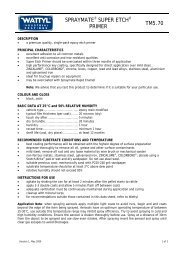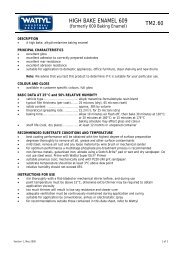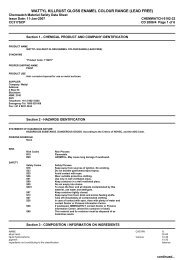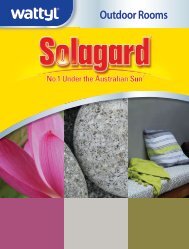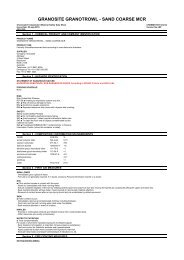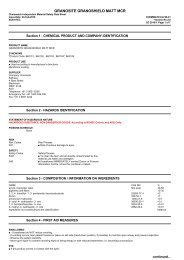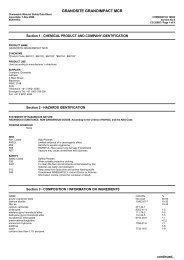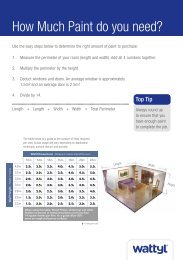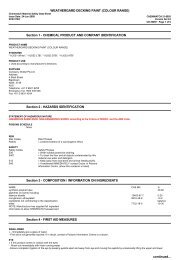Chemwatch MSDS Print - Wattyl
Chemwatch MSDS Print - Wattyl
Chemwatch MSDS Print - Wattyl
Create successful ePaper yourself
Turn your PDF publications into a flip-book with our unique Google optimized e-Paper software.
Granosite Granoglaze Satin<br />
Hazard Alert Code: MODERATE<br />
<strong>Chemwatch</strong> Material Safety Data Sheet<br />
Issue Date: 22-Nov-2010 CHEMWATCH 5079-69<br />
X9317SP<br />
Version No:8.1.1.1<br />
Page 1 of 8<br />
Section 1 - CHEMICAL PRODUCT AND COMPANY IDENTIFICATION<br />
PRODUCT NAME<br />
Granosite Granoglaze Satin<br />
PRODUCT USE<br />
SUPPLIER<br />
Company: Granosite<br />
Address:<br />
4 Steel Street<br />
Blacktown<br />
NSW, 2148<br />
Australia<br />
Telephone: +61 2 9621 6255<br />
Emergency Tel:+61 1800 039 008<br />
Fax: +61 2 9831 4244<br />
Section 2 - HAZARDS IDENTIFICATION<br />
STATEMENT OF HAZARDOUS NATURE<br />
NON-HAZARDOUS SUBSTANCE. NON-DANGEROUS GOODS. According to NOHSC Criteria, and ADG Code.<br />
RISK<br />
Risk Codes<br />
Risk Phrases<br />
R52<br />
• Harmful to aquatic organisms.<br />
R22 • Ingestion may produce health damage*.<br />
R33 • Cumulative effects may result following exposure*.<br />
R36/38<br />
• May produce discomfort of the eyes and skin*.<br />
SAFETY<br />
Safety Codes<br />
S23<br />
S24<br />
S25<br />
S37<br />
S39<br />
S26<br />
Safety Phrases<br />
• Do not breathe gas/fumes/vapour/spray.<br />
• Avoid contact with skin.<br />
• Avoid contact with eyes.<br />
• Wear suitable gloves.<br />
• Wear eye/face protection.<br />
• In case of contact with eyes, rinse with plenty of water and contact Doctor or<br />
Poisons Information Centre.<br />
Section 3 - COMPOSITION / INFORMATION ON INGREDIENTS<br />
NAME CAS RN %<br />
acrylic polymer latex Not avail. 30-60<br />
residual monomer<br />
trace<br />
silica precipitated, crystalline free 112926-00-8 1-2<br />
ammonium hydroxide 1336-21-6
Granosite Granoglaze Satin<br />
Hazard Alert Code: MODERATE<br />
<strong>Chemwatch</strong> Material Safety Data Sheet<br />
Issue Date: 22-Nov-2010 CHEMWATCH 5079-69<br />
X9317SP<br />
Version No:8.1.1.1<br />
Page 2 of 8<br />
Section 4 - FIRST AID MEASURES<br />
SWALLOWED<br />
• If swallowed do NOT induce vomiting.<br />
• If vomiting occurs, lean patient forward or place on left side (head-down position, if possible) to maintain open airway and<br />
prevent aspiration.<br />
• Observe the patient carefully.<br />
• Never give liquid to a person showing signs of being sleepy or with reduced awareness; i.e. becoming unconscious.<br />
EYE<br />
■ If this product comes in contact with the eyes:<br />
• Wash out immediately with fresh running water.<br />
• Ensure complete irrigation of the eye by keeping eyelids apart and away from eye and moving the eyelids by occasionally lifting<br />
the upper and lower lids.<br />
• Seek medical attention without delay; if pain persists or recurs seek medical attention.<br />
• Removal of contact lenses after an eye injury should only be undertaken by skilled personnel.<br />
SKIN<br />
■ If skin contact occurs:<br />
• Immediately remove all contaminated clothing, including footwear.<br />
• Flush skin and hair with running water (and soap if available).<br />
• Seek medical attention in event of irritation.<br />
INHALED<br />
• If fumes, aerosols or combustion products are inhaled remove from contaminated area.<br />
• Other measures are usually unnecessary.<br />
NOTES TO PHYSICIAN<br />
For acute or short term repeated exposures to ammonia and its solutions:<br />
• Mild to moderate inhalation exposures produce headache, cough, bronchospasm, nausea, vomiting, pharyngeal and retrosternal pain<br />
and conjunctivitis. Severe inhalation produces laryngospasm, signs of upper airway obstruction (stridor, hoarseness, difficulty<br />
in speaking) and, in excessively, high doses, pulmonary oedema.<br />
• Warm humidified air may soothe bronchial irritation.<br />
• Test all patients with conjunctival irritation for corneal abrasion (fluorescein stain, slit lamp exam)<br />
• Dyspneic patients should receive a chest X-ray and arterial blood gases to detect pulmonary oedema.<br />
Treat symptomatically.<br />
Section 5 - FIRE FIGHTING MEASURES<br />
EXTINGUISHING MEDIA<br />
■ The product contains a substantial proportion of water, therefore there are no restrictions on the type of extinguishing media<br />
which may be used. Choice of extinguishing media should take into account surrounding areas.<br />
Though the material is non-combustible, evaporation of water from the mixture, caused by the heat of nearby fire, may produce<br />
floating layers of combustible substances.<br />
In such an event consider:<br />
• foam.<br />
FIRE FIGHTING<br />
• Alert Fire Brigade and tell them location and nature of hazard.<br />
• Wear breathing apparatus plus protective gloves in the event of a fire.<br />
• Prevent, by any means available, spillage from entering drains or water courses.<br />
• Use fire fighting procedures suitable for surrounding area.<br />
FIRE/EXPLOSION HAZARD<br />
• The material is not readily combustible under normal conditions.<br />
• However, it will break down under fire conditions and the organic component may burn.<br />
• Not considered to be a significant fire risk.<br />
• Heat may cause expansion or decomposition with violent rupture of containers.<br />
Decomposes on heating and produces toxic fumes of: carbon dioxide (CO2), other pyrolysis products typical of burning organic<br />
material.<br />
May emit poisonous fumes.<br />
continued...
Granosite Granoglaze Satin<br />
Hazard Alert Code: MODERATE<br />
<strong>Chemwatch</strong> Material Safety Data Sheet<br />
Issue Date: 22-Nov-2010 CHEMWATCH 5079-69<br />
X9317SP<br />
Version No:8.1.1.1<br />
Page 3 of 8<br />
Section 5 - FIRE FIGHTING MEASURES<br />
FIRE INCOMPATIBILITY<br />
■ None known.<br />
HAZCHEM<br />
None<br />
Section 6 - ACCIDENTAL RELEASE MEASURES<br />
MINOR SPILLS<br />
Slippery when spilt.<br />
• Clean up all spills immediately.<br />
• Avoid breathing vapours and contact with skin and eyes.<br />
• Control personal contact with the substance, by using protective equipment.<br />
• Contain and absorb spill with sand, earth, inert material or vermiculite.<br />
MAJOR SPILLS<br />
Slippery when spilt.<br />
Moderate hazard.<br />
• Clear area of personnel and move upwind.<br />
• Alert Fire Brigade and tell them location and nature of hazard.<br />
• Wear breathing apparatus plus protective gloves.<br />
• Prevent, by any means available, spillage from entering drains or water course.<br />
Personal Protective Equipment advice is contained in Section 8 of the <strong>MSDS</strong>.<br />
Section 7 - HANDLING AND STORAGE<br />
PROCEDURE FOR HANDLING<br />
• DO NOT allow clothing wet with material to stay in contact with skin.<br />
• Avoid all personal contact, including inhalation.<br />
• Wear protective clothing when risk of exposure occurs.<br />
• Use in a well-ventilated area.<br />
• Prevent concentration in hollows and sumps.<br />
SUITABLE CONTAINER<br />
• Polyethylene or polypropylene container.<br />
• Packing as recommended by manufacturer.<br />
• Check all containers are clearly labelled and free from leaks.<br />
STORAGE INCOMPATIBILITY<br />
None known.<br />
STORAGE REQUIREMENTS<br />
• Store in original containers.<br />
• Keep containers securely sealed.<br />
• Store in a cool, dry, well-ventilated area.<br />
• Store away from incompatible materials and foodstuff containers.<br />
Section 8 - EXPOSURE CONTROLS / PERSONAL PROTECTION<br />
EXPOSURE CONTROLS<br />
Source Material TWA TWA STEL STEL Peak Peak TWA Notes<br />
ppm mg/m³ ppm mg/m³ ppm mg/m³ F/CC<br />
__________ __________ ______ ______ ______ ______ ______ ______ ______ ______<br />
continued...
Granosite Granoglaze Satin<br />
Hazard Alert Code: MODERATE<br />
<strong>Chemwatch</strong> Material Safety Data Sheet<br />
Issue Date: 22-Nov-2010 CHEMWATCH 5079-69<br />
X9317SP<br />
Version No:8.1.1.1<br />
Page 4 of 8<br />
Section 8 - EXPOSURE CONTROLS / PERSONAL PROTECTION<br />
Source Material TWA TWA STEL STEL Peak Peak TWA Notes<br />
ppm mg/m³ ppm mg/m³ ppm mg/m³ F/CC<br />
__________ __________ ______ ______ ______ ______ ______ ______ ______ ______<br />
Australia silica 10 (see Chapter 14)<br />
Exposure<br />
precipitated,<br />
Standards<br />
crystalline free<br />
(Silica -<br />
Amorphous Silica<br />
gel (a))<br />
Australia ammonium 25 17 35 24<br />
Exposure<br />
hydroxide<br />
Standards<br />
(Ammonia)<br />
The following materials had no OELs on our records<br />
• water: CAS:7732- 18- 5<br />
MATERIAL DATA<br />
ACRYLIC POLYMER LATEX:<br />
AMMONIUM HYDROXIDE:<br />
GRANOSITE GRANOGLAZE SATIN:<br />
for exposure to ammonia gas/ vapours:<br />
Odour Threshold Value: Variously reported as 0.019 ppm and 55 ppm; AIHA Value 16.7 ppm (detection)<br />
NOTE: Detector tubes for ammonia, measuring in excess of 1 ppm, are commercially available.<br />
The TLV-TWA is thought to be protective against irritation of the eyes and respiratory tract and minimise discomfort among<br />
workers that are not inured to its effects and systemic damage.<br />
GRANOSITE GRANOGLAZE SATIN:<br />
SILICA PRECIPITATED, CRYSTALLINE FREE:<br />
For amorphous crystalline silica (precipitated silicic acid):<br />
Amorphous crystalline silica shows little potential for producing adverse effects on the lung and exposure standards should<br />
reflect a particulate of low intrinsic toxicity. Mixtures of amorphous silicas/ diatomaceous earth and crystalline silica should<br />
be monitored as if they comprise only the crystalline forms.<br />
The dusts from precipitated silica and silica gel produce little adverse effect on pulmonary functions and are not known to<br />
produce significant disease or toxic effect.<br />
IARC has classified silica, amorphous as Group 3: NOT classifiable as to its carcinogenicity to humans.<br />
SILICA PRECIPITATED, CRYSTALLINE FREE:<br />
The concentration of dust, for application of respirable dust limits, is to be determined from the fraction that penetrates a<br />
separator whose size collection efficiency is described by a cumulative log-normal function with a median aerodynamic diameter of<br />
4.0 µm (+-) 0.3 µm and with a geometric standard deviation of 1.5 µm (+-) 0.1 µm, i.e..generally less than 5 µm.<br />
WATER:<br />
No exposure limits set by NOHSC or ACGIH.<br />
PERSONAL PROTECTION<br />
RESPIRATOR<br />
•Type AK Filter of sufficient capacity. (AS/NZS 1716 & 1715, EN 143:2000 & 149:2001, ANSI Z88 or national equivalent)<br />
EYE<br />
• Safety glasses with side shields.<br />
• Chemical goggles.<br />
• Contact lenses may pose a special hazard; soft contact lenses may absorb and concentrate irritants. A written policy document,<br />
describing the wearing of lens or restrictions on use, should be created for each workplace or task. This should include a<br />
review of lens absorption and adsorption for the class of chemicals in use and an account of injury experience. Medical and<br />
first-aid personnel should be trained in their removal and suitable equipment should be readily available. In the event of<br />
chemical exposure, begin eye irrigation immediately and remove contact lens as soon as practicable. Lens should be removed at<br />
the first signs of eye redness or irritation - lens should be removed in a clean environment only after workers have washed<br />
hands thoroughly. [CDC NIOSH Current Intelligence Bulletin 59], [AS/NZS 1336 or national equivalent].<br />
HANDS/FEET<br />
• Wear chemical protective gloves, e.g. PVC.<br />
• Wear safety footwear or safety gumboots, e.g. Rubber.<br />
The selection of the suitable gloves does not only depend on the material, but also on further marks of quality which vary from<br />
continued...
Granosite Granoglaze Satin<br />
Hazard Alert Code: MODERATE<br />
<strong>Chemwatch</strong> Material Safety Data Sheet<br />
Issue Date: 22-Nov-2010 CHEMWATCH 5079-69<br />
X9317SP<br />
Version No:8.1.1.1<br />
Page 5 of 8<br />
Section 8 - EXPOSURE CONTROLS / PERSONAL PROTECTION<br />
manufacturer to manufacturer. Where the chemical is a preparation of several substances, the resistance of the glove material can<br />
not be calculated in advance and has therefore to be checked prior to the application.<br />
The exact break through time for substances has to be obtained from the manufacturer of the protective gloves and<br />
has to be observed when making a final choice.<br />
Suitability and durability of glove type is dependent on usage. Important factors in the selection of gloves include:<br />
OTHER<br />
• Overalls.<br />
• P.V.C. apron.<br />
• Barrier cream.<br />
• Skin cleansing cream.<br />
ENGINEERING CONTROLS<br />
■ Engineering controls are used to remove a hazard or place a barrier between the worker and the hazard. Well-designed<br />
engineering controls can be highly effective in protecting workers and will typically be independent of worker interactions to<br />
provide this high level of protection.<br />
The basic types of engineering controls are:<br />
Process controls which involve changing the way a job activity or process is done to reduce the risk.<br />
Enclosure and/or isolation of emission source which keeps a selected hazard "physically" away from the worker and ventilation<br />
that strategically "adds" and "removes" air in the work environment.<br />
Section 9 - PHYSICAL AND CHEMICAL PROPERTIES<br />
PHYSICAL PROPERTIES<br />
Liquid.<br />
Mixes with water.<br />
State Liquid Molecular Weight Not Applicable<br />
Melting Range (°C) Not Available Viscosity Not Available<br />
Boiling Range (°C) 100 approx Solubility in water (g/L) Miscible<br />
Flash Point (°C) Not Applicable pH (1% solution) Not Available<br />
Decomposition Temp (°C) Not Available pH (as supplied) 10<br />
Autoignition Temp (°C) Not Applicable Vapour Pressure (kPa) As water<br />
Upper Explosive Limit (%) Not Applicable Specific Gravity (water=1) 1.02- 1.07<br />
Lower Explosive Limit (%) Not Applicable Relative Vapour Density >1<br />
(air=1)<br />
Volatile Component (%vol) 70- 80 Evaporation Rate As water<br />
Section 10 - STABILITY AND REACTIVITY<br />
CONDITIONS CONTRIBUTING TO INSTABILITY<br />
• Presence of incompatible materials.<br />
• Product is considered stable.<br />
• Hazardous polymerisation will not occur.<br />
For incompatible materials - refer to Section 7 - Handling and Storage.<br />
Section 11 - TOXICOLOGICAL INFORMATION<br />
POTENTIAL HEALTH EFFECTS<br />
ACUTE HEALTH EFFECTS<br />
SWALLOWED<br />
■ Accidental ingestion of the material may be damaging to the health of the individual.<br />
EYE<br />
■ There is some evidence to suggest that this material can cause eye irritation and damage in some persons.<br />
continued...
Granosite Granoglaze Satin<br />
Hazard Alert Code: MODERATE<br />
<strong>Chemwatch</strong> Material Safety Data Sheet<br />
Issue Date: 22-Nov-2010 CHEMWATCH 5079-69<br />
X9317SP<br />
Version No:8.1.1.1<br />
Page 6 of 8<br />
Section 11 - TOXICOLOGICAL INFORMATION<br />
SKIN<br />
■ There is some evidence to suggest that this material can cause inflammation of the skin on contact in some persons.<br />
Open cuts, abraded or irritated skin should not be exposed to this material.<br />
Entry into the blood-stream, through, for example, cuts, abrasions or lesions, may produce systemic injury with harmful effects.<br />
Examine the skin prior to the use of the material and ensure that any external damage is suitably protected.<br />
INHALED<br />
■ The material is not thought to produce either adverse health effects or irritation of the respiratory tract following<br />
inhalation (as classified by EC Directives using animal models). Nevertheless, adverse systemic effects have been produced<br />
following exposure of animals by at least one other route and good hygiene practice requires that exposure be kept to a minimum<br />
and that suitable control measures be used in an occupational setting.<br />
Inhalation hazard is increased at higher temperatures.<br />
CHRONIC HEALTH EFFECTS<br />
■ Substance accumulation, in the human body, may occur and may cause some concern following repeated or long-term occupational<br />
exposure.<br />
Prolonged or repeated minor exposure to ammonia gas/vapour may cause long-term irritation to the eyes, nose and upper respiratory<br />
tract. Repeated exposure or prolonged contact may produce dermatitis, and conjunctivitis.
Granosite Granoglaze Satin<br />
Hazard Alert Code: MODERATE<br />
<strong>Chemwatch</strong> Material Safety Data Sheet<br />
Issue Date: 22-Nov-2010 CHEMWATCH 5079-69<br />
X9317SP<br />
Version No:8.1.1.1<br />
Page 7 of 8<br />
Section 14 - TRANSPORTATION INFORMATION<br />
HAZCHEM:<br />
None (ADG7)<br />
NOT REGULATED FOR TRANSPORT OF DANGEROUS GOODS: UN, IATA, IMDG<br />
Section 15 - REGULATORY INFORMATION<br />
POISONS SCHEDULE<br />
None<br />
REGULATIONS<br />
Regulations for ingredients<br />
silica precipitated, crystalline free (CAS: 112926-00-8) is found on the following regulatory<br />
lists;<br />
"Australia - New South Wales Hazardous Substances Requiring Health Surveillance", "Australia - Queensland Workplace Health and<br />
Safety Regulation - Hazardous substances for which health surveillance must be supplied", "Australia - South Australia -<br />
Hazardous Substances Requiring Health Surveillance", "Australia - Tasmania Hazardous Substances Requiring Health Surveillance",<br />
"Australia - Western Australia Hazardous Substances Prohibited for Specified Uses or Methods of Handling", "Australia - Western<br />
Australia Hazardous Substances Requiring Health Surveillance", "Australia Australian Safety and Compensation Council (ASCC) Draft<br />
National Code of Practice for the Control of Workplace Hazardous Chemicals - Schedule 4 Hazardous chemicals Requiring Health<br />
Surveillance", "Australia Exposure Standards", "Australia Hazardous Substances", "Australia High Volume Industrial Chemical List<br />
(HVICL)", "Australia Inventory of Chemical Substances (AICS)", "Australia Occupational Health and Safety (Commonwealth<br />
Employment) (National Standards) Regulations 1994 - Hazardous Substances Requiring Health Surveillance", "Australia Work Health<br />
and Safety Regulations 2011 - Hazardous chemicals (other than lead) requiring health monitoring", "International Council of<br />
Chemical Associations (ICCA) - High Production Volume List", "International Fragrance Association (IFRA) Survey: Transparency<br />
List", "OECD List of High Production Volume (HPV) Chemicals"<br />
ammonium hydroxide (CAS: 1336-21-6) is found on the following regulatory lists;<br />
"Australia - Australian Capital Territory - Environment Protection Regulation: Ambient environmental standards (AQUA/1 to 6 -<br />
inorganic chemicals)", "Australia - Australian Capital Territory - Environment Protection Regulation: Ambient environmental<br />
standards (Domestic water supply - inorganic chemicals)", "Australia - Australian Capital Territory - Environment Protection<br />
Regulation: Pollutants entering waterways taken to cause environmental harm - Domestic water supply quality", "Australia -<br />
Australian Capital Territory - Environment Protection Regulation: Pollutants entering waterways taken to cause environmental harm<br />
(Aquatic habitat)", "Australia - Queensland Hazardous Materials and Prescribed Quantities for Major Hazard Facilities",<br />
"Australia - Victoria Drugs, Poisons and Controlled Substances (Precursor Chemicals) Regs 2007 - Schedule 1 - Precursor<br />
Chemicals and Quantities", "Australia - Victoria Occupational Health and Safety Regulations - Schedule 9: Materials at Major<br />
Hazard Facilities (And Their Threshold Quantity) Table 2", "Australia Council of Australian Governments (COAG) Chemicals of<br />
Security Concern", "Australia Drinking Water Guideline Values For Physical and Chemical Characteristics", "Australia Exposure<br />
Standards", "Australia Hazardous Substances", "Australia High Volume Industrial Chemical List (HVICL)", "Australia Inventory of<br />
Chemical Substances (AICS)", "Australia National Pollutant Inventory", "Australia Standard for the Uniform Scheduling of<br />
Medicines and Poisons (SUSMP) - Appendix E (Part 2)", "Australia Standard for the Uniform Scheduling of Medicines and Poisons<br />
(SUSMP) - Appendix F (Part 3)", "Australia Standard for the Uniform Scheduling of Medicines and Poisons (SUSMP) - Schedule 5",<br />
"Australia Standard for the Uniform Scheduling of Medicines and Poisons (SUSMP) - Schedule 6", "Australia Work Health and Safety<br />
Regulations 2011 - Hazardous chemicals at major hazard facilities and their threshold quantity", "CODEX General Standard for Food<br />
Additives (GSFA) - Additives Permitted for Use in Food in General, Unless Otherwise Specified, in Accordance with GMP",<br />
"GESAMP/EHS Composite List - GESAMP Hazard Profiles", "IMO IBC Code Chapter 17: Summary of minimum requirements", "IMO MARPOL<br />
73/78 (Annex II) - List of Noxious Liquid Substances Carried in Bulk", "International Council of Chemical Associations (ICCA) -<br />
High Production Volume List", "International Fragrance Association (IFRA) Survey: Transparency List", "OECD List of High<br />
Production Volume (HPV) Chemicals", "WHO Guidelines for Drinking-water Quality - Chemicals for which guideline values have not<br />
been established"<br />
water (CAS: 7732-18-5) is found on the following regulatory lists;<br />
"Australia High Volume Industrial Chemical List (HVICL)", "Australia Inventory of Chemical Substances (AICS)", "IMO IBC Code<br />
Chapter 18: List of products to which the Code does not apply", "International Fragrance Association (IFRA) Survey: Transparency<br />
List", "OECD List of High Production Volume (HPV) Chemicals", "OSPAR National List of Candidates for Substitution – Norway"<br />
continued...
Granosite Granoglaze Satin<br />
Hazard Alert Code: MODERATE<br />
<strong>Chemwatch</strong> Material Safety Data Sheet<br />
Issue Date: 22-Nov-2010 CHEMWATCH 5079-69<br />
X9317SP<br />
Version No:8.1.1.1<br />
Page 8 of 8<br />
Section 15 - REGULATORY INFORMATION<br />
No data for Granosite Granoglaze Satin (CW: 5079-69)<br />
No data for acrylic polymer latex (CAS: , Not avail)<br />
Section 16 - OTHER INFORMATION<br />
■ Classification of the preparation and its individual components has drawn on official and authoritative sources as well as<br />
independent review by the <strong>Chemwatch</strong> Classification committee using available literature references.<br />
A list of reference resources used to assist the committee may be found at:<br />
www.chemwatch.net/references.<br />
■ The (M)SDS is a Hazard Communication tool and should be used to assist in the Risk Assessment. Many factors determine whether<br />
the reported Hazards are Risks in the workplace or other settings.<br />
This document is copyright. Apart from any fair dealing for the purposes of private study, research, review or<br />
criticism, as permitted under the Copyright Act, no part may be reproduced by any process without written<br />
permission from CHEMWATCH. TEL (+61 3) 9572 4700.<br />
Issue Date: 22-Nov-2010<br />
<strong>Print</strong> Date: 28-Nov-2012<br />
This is the end of the <strong>MSDS</strong>.




